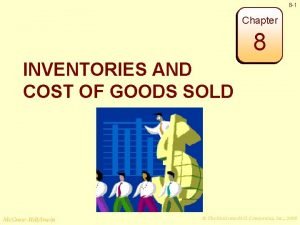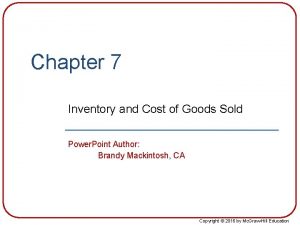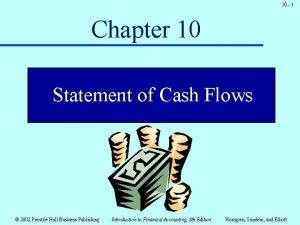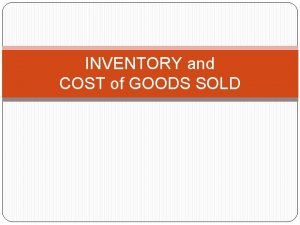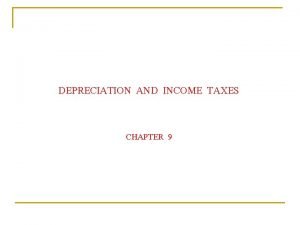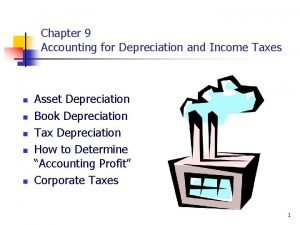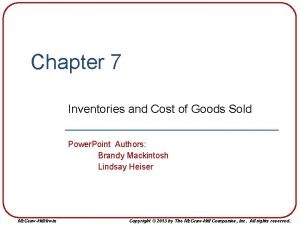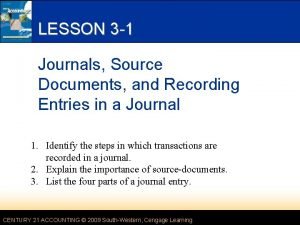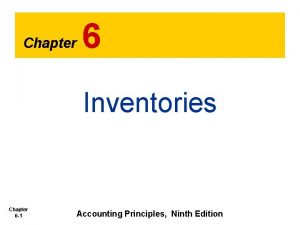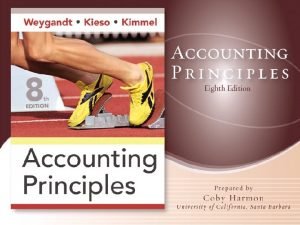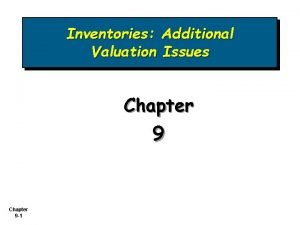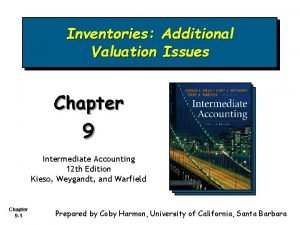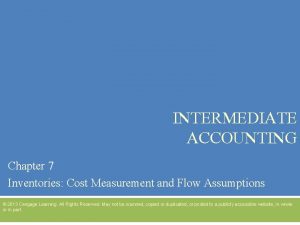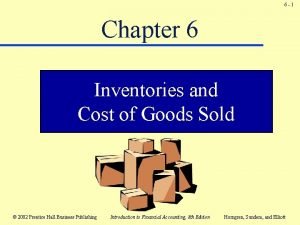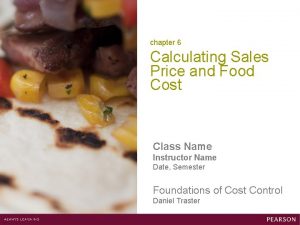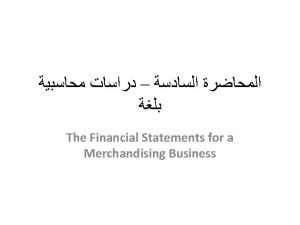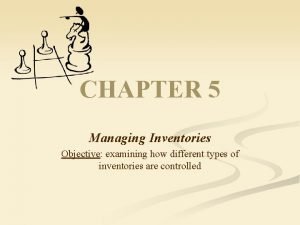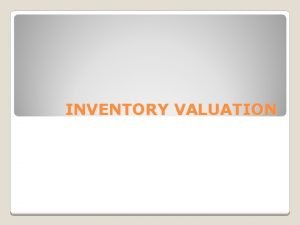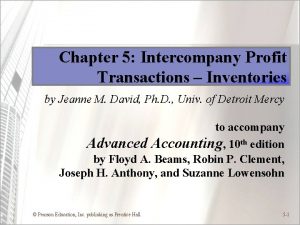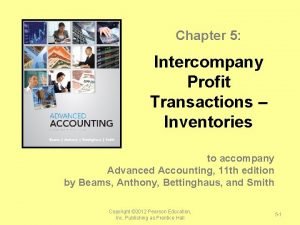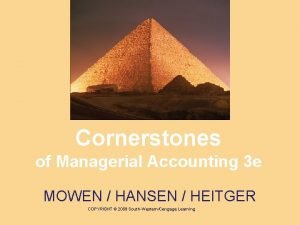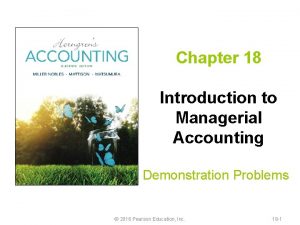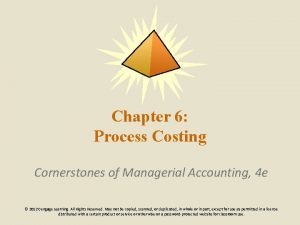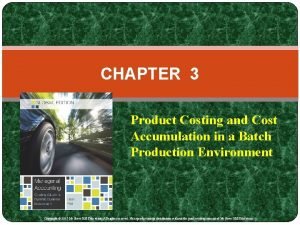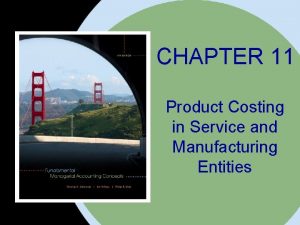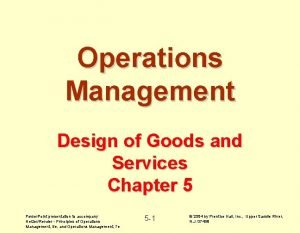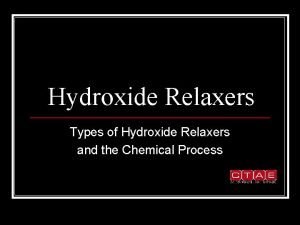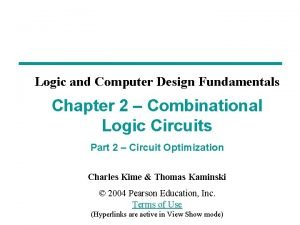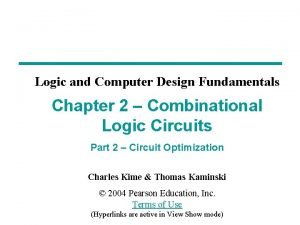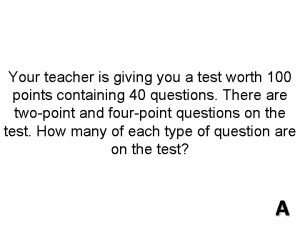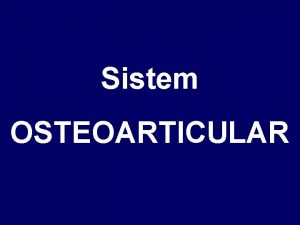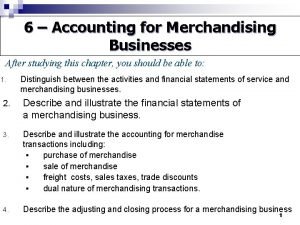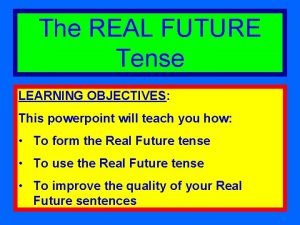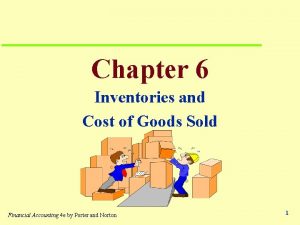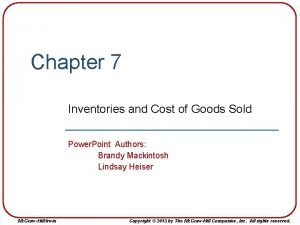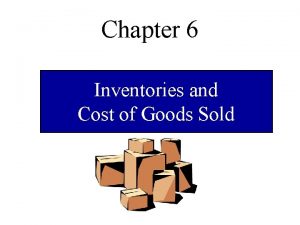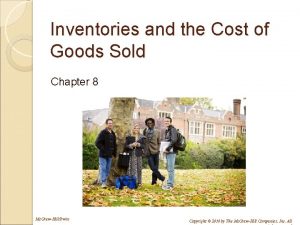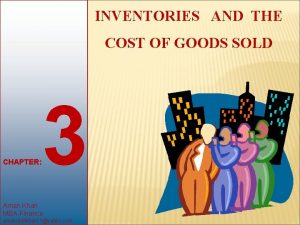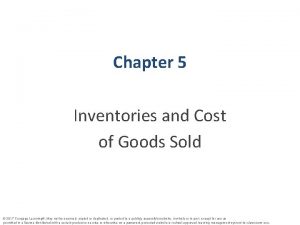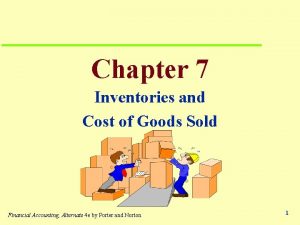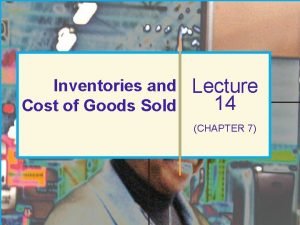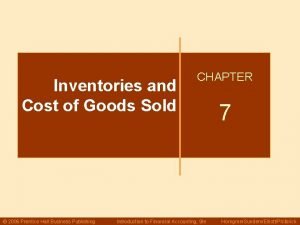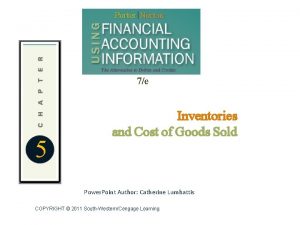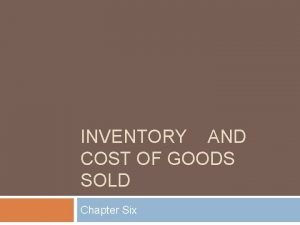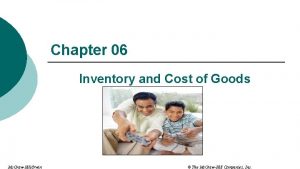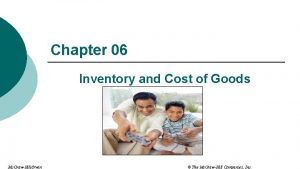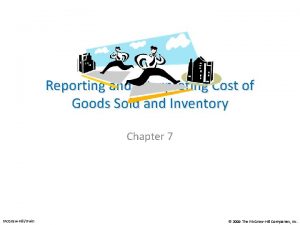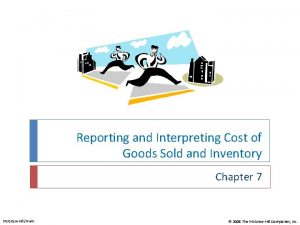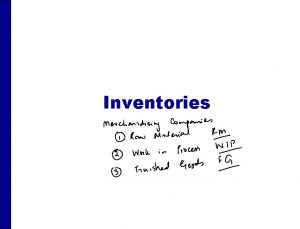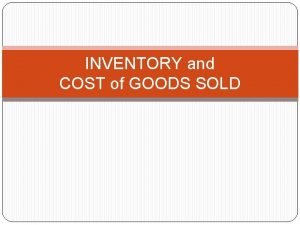Chapter 5 Inventories and Cost of Goods Sold


![Gap, Inc. Consolidated Balance Sheets [Partial] ASSETS (in millions) CURRENT ASSETS: Cash and cash Gap, Inc. Consolidated Balance Sheets [Partial] ASSETS (in millions) CURRENT ASSETS: Cash and cash](https://slidetodoc.com/presentation_image_h2/4716d977f27da0a0b5b717bfac334f4c/image-3.jpg)


![Caterpillar, Inc. Consolidated Balance Sheets [Partial] ASSETS (in millions) Current assets: Inventories: Raw materials Caterpillar, Inc. Consolidated Balance Sheets [Partial] ASSETS (in millions) Current assets: Inventories: Raw materials](https://slidetodoc.com/presentation_image_h2/4716d977f27da0a0b5b717bfac334f4c/image-6.jpg)






























































- Slides: 68

Chapter 5 Inventories and Cost of Goods Sold Using Financial Accounting Information: The Alternative to Debits and Credits , 6/e by Gary A. Porter and Curtis L. Norton Copyright © 2009 South-Western, a part of Cengage Learning.

Inventory of Wholesalers and Retailers v Purchased in finished form v Resold without transformation v Classified as “Merchandise Inventory” on balance sheet LO 1
![Gap Inc Consolidated Balance Sheets Partial ASSETS in millions CURRENT ASSETS Cash and cash Gap, Inc. Consolidated Balance Sheets [Partial] ASSETS (in millions) CURRENT ASSETS: Cash and cash](https://slidetodoc.com/presentation_image_h2/4716d977f27da0a0b5b717bfac334f4c/image-3.jpg)
Gap, Inc. Consolidated Balance Sheets [Partial] ASSETS (in millions) CURRENT ASSETS: Cash and cash equivalents More Marketable securities Accounts receivable than Merchandise inventory 1/3 of Other current TOTAL CURRENT ASSETSassets February 3, 2007 $ 2, 030 570 44 1, 796 589 5, 029 Janurary 28, 2006 $ 2, 035 952 55 1, 696 501 5, 239

Inventory of Manufacturers Costs Included in Inventory Direct materials Direct labor Manufacturing overhead

Inventory of Manufacturers Balance Sheet Classifications Costs Included in Inventory Direct materials Direct labor Manufacturing overhead Raw materials Manufacture products Work in process Finished goods
![Caterpillar Inc Consolidated Balance Sheets Partial ASSETS in millions Current assets Inventories Raw materials Caterpillar, Inc. Consolidated Balance Sheets [Partial] ASSETS (in millions) Current assets: Inventories: Raw materials](https://slidetodoc.com/presentation_image_h2/4716d977f27da0a0b5b717bfac334f4c/image-6.jpg)
Caterpillar, Inc. Consolidated Balance Sheets [Partial] ASSETS (in millions) Current assets: Inventories: Raw materials Work in progress Finished goods Supplies Total inventories 2006 $ 2, 182 977 2, 915 277 $ 6, 351

Condensed Income Statement for a Merchandiser Net sales Cost of goods sold Gross profit Selling and administrative expenses Net income before tax Income tax expense Net income $100, 000 60, 000 $ 40, 000 29, 300 $ 10, 700 4, 280 $ 6, 420 LO 2

Net Sales and Contra-Sales Accounts Normal Sales revenue v The inflow of either cash or accounts receivable from thebalance sale of a product Two deductions from sales: vnormal sales returns and allowances normal v debit sales discounts debit balance

Sales Returns and Allowances v records inventory returned by customers Normal who are not completely satisfied v a customer may be given an allowance for balance spoiled or damaged merchandise v single account used to record both returns and allowances normal debit balance

Credit Terms and Sales Discounts n/30 Payment due 30 days from invoice 1/10, n/30 Deduct 1% of invoice amount if paid within 10 days; otherwise full invoice amount is due in 30 days 2/10, n/30 Deduct 2% of invoice amount if paid within 10 days; otherwise full invoice amount is due in 30 days

Net Sales revenue Less: Sales returns and allowances Sales discounts Net sales $103, 500 2, 000 1, 500 $100, 000

The Cost of Goods Sold Model Beginning inventory + Purchases of merchandise = Goods Available for Sale Less: Ending inventory = Cost of goods sold LO 3

The Cost of Goods Sold Model Beginning inventory $ 15, 000 + Cost of goods purchased 63, 000 = Cost of goods available for sale 78, 000 – Ending inventory (18, 000) = Cost of goods sold $ 60, 000 “Pool” of goods available to sell during the period An increase in ending inventory means more was bought than sold

Perpetual Inventory Systems Inventory records are updated after each purchase or sale v Point-of-sale terminals have improved the ability of mass merchandisers to maintain perpetual systems

Periodic Inventory Systems Inventory records are updated periodically based on physical inventory counts v Reduces record keeping but also decreases the ability to track theft, breakage, etc. , and prepare interim financial statements

Cost of Goods Purchased v Includes invoice price: Less: Purchase returns and allowances Purchase discounts Plus: Transportation-in

Recording Purchases Balance Sheet Assets = Liabilities + Stockholders’ + Equity Accounts Payable 4, 000 Income Statement Revenues -- Expenses To record purchase of inventory. Purchases (4, 000)

Recording Purchase Returns and Allowances Balance Sheet Assets = Income Statement Liabilities + Stockholders’ + Revenues -- Expenses Equity Accounts Purchase Returns and Payable (850) Allowances 850 To record inventory returned to supplier.

Recording Purchase Discounts Balance Sheet Assets Income Statement = Liabilities + Stockholders’ + Revenues -- Expenses Equity Cash (495) Accounts Purchase Payable (500) Discounts 5 ($ 500 × 1% = $5 discount) To record payment within discount period to supplier who offers 1% purchase discount.

FOB Destination Point Title passes at destination v No sale or purchase until inventory reaches its destination v Seller responsible for inventory while in transit

FOB Shipping Point v Both sale and purchase recorded upon shipment v Buyer responsible for inventory while in transit Title passes when shipped

Analysis of Profitability Of particular interest to current and potential investors Gross Profit % LO 4

Daisy’s Profitability Net sales Cost of goods sold Gross profit ratio Gross Profit Ratio = = $100, 000 60, 000 $ 40, 000 40% Gross Profit Net Sales (How many cents on every $ of sales are left over after covering the cost of the product)

Inventory Valuation and Income Measurement Value assigned to inventory on balance sheet When Sold = Value expensed as cost of goods sold on income statement LO 5

Inventory Costs Included v Any freight costs incurred by buyer v Cost of insurance for inventory in transit v Cost of storing inventory before selling v Excise and sales taxes

Inventory Costing Methods Four costing methods available: Specific Identification Weighted Average First-in, First-out (FIFO) Last-in, First-out (LIFO) LO 6

Detailed Costing Method Example Beginning inventory, Jan. 1: 500 units (unit cost $10) Inventory purchases: Date Units 1/20 300 4/8 400 9/5 200 12/12 100 Total purchases 1, 000 units Unit Cost $ 11 12 13 14 Ending inventory, Dec. 31: 600 units Calculate the cost of goods sold and ending inventory under each cost flow method

Specific Identification Method Step 1: Identify the specific units in inventory at the end of the year and their costs.

Specific Identification Method Units in ending inventory: Date purchased Units Cost Total Cost 1/20 100 $11 $ 1, 100 4/8 300 12 3, 600 9/5 200 13 2, 600 Ending inventory 600 Units × Cost = Total cost $ 7, 300

Specific Identification Method Step 2: Identify the units sold and calculate the cost of goods sold.

Specific Identification Method Date purchased Units Cost Total Cost Beg. inventory 500 $10 $5, 000 1/20 200 11 2, 200 4/8 100 12 1, 200 12/12 100 14 1, 400 Cost of goods sold 900 $9, 800 Units × Cost = Total cost

Weighted Average Method Step 1: Calculate the cost of goods available for sale.

Weighted Average Method Date purchased Units Cost Total cost Beg. inventory 500 $10 $ 5, 000 1/20 300 11 3, 300 4/8 400 12 4, 800 9/5 200 13 2, 600 12/12 100 Cost of goods available for sale 1, 500 14 1, 400 $17, 100

Weighted Average Method Step 2: Divide the cost of goods available for sale by the total units to determine the weighted average cost per unit.

Weighted Average Method Cost of Goods Available for Sale Units Available for Sale $17, 100 = $11. 40/unit 1, 500

Weighted Average Method Step 3: Calculate ending inventory and cost of goods sold by multiplying the weighted average cost per unit by the number of units in ending inventory and the number of units sold. Avg. Cost × # of Units

Weighted Average Method Units on hand Units sold Weighted average cost × Total cost of goods available of $17, 100 allocated: ALLOCATE TO Ending Cost of Inventory Goods Sold 600 900 $11. 40 $6, 840 $10, 260

First-in, First-out (FIFO) Method Step 1: Assign the cost of the beginning inventory to cost of goods sold.

First-in, First-out (FIFO) Method Units Cost 1/1 500 $10 1/20 300 $11 4/8 400 $12 9/5 200 $13 12/12 100 $14 ALLOCATE TO Ending Cost of Inventory Goods Sold $5, 000

First-in, First-out (FIFO) Method Step 2: Continue to work forward until you assign the total number of units sold during the period to cost of goods sold. Allocate the remaining costs to ending inventory.

First-in, First-out (FIFO) Method ALLOCATE TO Ending Cost of Inventory Goods Sold Units Cost 1/1 500 $10 $5, 000 1/20 300 $11 3, 300 4/8 300 / 100 $12 9/5 200 $13 2, 600 12/12 100 $14 1, 400 TOTALS $3, 600 $7, 600 1, 200 $9, 500

Last-in, First-out (LIFO) Method Step 1: Assign the cost of the last units purchased to cost of goods sold.

Last-in, First-out (LIFO) Method Units Cost 1/1 500 $10 1/20 300 $11 4/8 400 $12 9/5 200 $13 12/12 100 $14 ALLOCATE TO Ending Cost of Inventory Goods Sold $1, 400

Last-in, First-out (LIFO) Method Step 2: Work backward until you assign the total number of units sold during the period to cost of goods sold (allocate the remaining costs to ending inventory).

Last-in, First-out (LIFO) Method ALLOCATE TO Ending Cost of Inventory Goods Sold Units Cost 1/1 500 $10 $5, 000 1/20 100 / 200 $11 1, 100 4/8 400 $12 4, 800 9/5 200 $13 2, 600 12/12 100 $14 1, 400 TOTALS $6, 100 $ 2, 200 $11, 000

Comparison of Costing Methods Specific Identification Weighted Average FIFO LIFO Ending Inventory Cost of Goods Sold Goods Available for Sale $7, 300 $ 9, 800 $17, 100 6, 840 10, 260 17, 100 7, 600 9, 500 17, 100 6, 100 11, 000 17, 100 LO 7

Comparison of Costing Methods Weighted Average FIFO LIFO In periods of rising prices: Highest cost of goods sold? Lowest cost of goods sold? Highest gross profit? Lowest net income? Lowest income taxes? X X X

LIFO Issues v LIFO liquidation • Liquidation can result in high gross profit (and large tax bill) v LIFO conformity rule • If used for tax, LIFO must also be used for books v LIFO reserve • Difference between inventory value stated at FIFO and value stated at LIFO

Reasons for Inventory Errors v Mathematical mistakes v Physical inventory counting errors v Cutoff problems – in-transit v Goods on consignment LO 8

Effect of Inventory Errors on the Income Statement, 2008 Sales Beginning inventory Add: Purchases Goods available for sale Less: Ending inventory Cost of goods sold Gross margin Operating expenses Net income OS = overstatement US = understatement Reported $1, 000 $ 200, 000 700, 000 $ 900, 000 300, 000 $ 600, 000 $ 400, 000 100, 000 $ 300, 000 Corrected Effect $1, 000 $ 200, 000 700, 000 $ 900, 000 250, 000 $50 OS $ 650, 000 50 US $ 350, 000 50 OS 100, 000 $ 250, 000 50 OS

Effect of Inventory Errors on the Income Statement, 2009 Sales Beginning inventory Add: Purchases Goods available for sale Less: Ending inventory Cost of goods sold Gross margin Operating expenses Net income OS = overstatement US = understatement Reported $1, 500, 000 $ 300, 000 1, 100, 000 $1, 400, 000 350, 000 $1, 050, 000 $ 450, 000 120, 000 $ 330, 000 Corrected Effect $1, 500, 000 $ 250, 000 $50 OS 1, 100, 000 $1, 350, 000 50 OS 350, 000 $1, 000 50 OS $ 500, 000 50 US 120, 000 $ 380, 000 50 US

Counterbalancing Errors Assume ending inventory is overstated (+) by $50, 000 in 2008: 2008 Beginning inventory xxx, xxx Add: Purchases xxx, xxx = Goods available for sale xxx, xxx Less: Ending inventory +50, 000 = Cost of goods sold – 50, 000

Counterbalancing Errors 2008 ending inventory becomes 2009 beginning inventory: 2008 2009 Beginning inventory $xxx, xxx +50, 000 Add: Purchases xxx, xxx = Goods available for sale xxx, xxx Less: Ending inventory +50, 000 = Cost of goods sold – 50, 000

Counterbalancing Errors The 2008 error reverses in 2009 (but 2008 inventory both 2008 and 2009 profits are misstated by 50, 000): 2008 2009 Beginning inventory $xxx, xxx $+50, 000 Add: Purchases xxx, xxx = Goods available for sale xxx, xxx +50, 000 Less: Ending inventory +50, 000 xxx, xxx = Cost of goods sold – 50, 000 +50, 000

Lower of Cost or Market Before Price Change Cost $100 After Price Change $80 Report loss in year market falls below cost… LO 9

Lower of Cost or Market Selling price Cost Gross profit % Before Price Change $100 75 $ 25 25% After Price Change in a t ain oss $ 80 m o r n t g l … ma e h r w 60 no it % f o r p $ 20 sold 25%

Lower of Cost or Market v Market = replacement cost (not retail value) v Cost determined under one of the costing methods v Justified on basis of conservatism v Can be applied to: • Entire inventory • Individual items • Groups of items

Estimating Inventory Value v Sometimes impossible or impractical to measure inventory at cost • Estimation is necessary v Two methods used to estimate ending inventory values: • Gross profit method • Retail inventory method LO 10

Gross Profit Method Beginning Inventory + Purchases = Cost of Goods Available for Sale – Ending Inventory = Cost of Goods Sold Use income statement model but reverse last two steps

Gross Profit Method Beginning inventory $1, 200 + Purchases = Cost of goods available for sale – Cost of goods sold (estimated)* = Ending inventory (estimated) 3, 500 4, 700 4, 200 $ 500 *Cost of goods sold is estimated as a percentage of sales

Inventory Turnover Ratio Cost of Goods Sold Average Inventory The number of times period inventory is turned over (i. e. , sold) LO 11

Number of Days’ Sales in Inventory Number of Days in the Period Inventory Turnover Ratio The average number of days inventory is on hand before it’s sold

Statement of Cash Flows from Operating Activities: Net income Increase in inventory Decrease in inventory Increase in accounts payable Decrease in accounts payable Indirect Method - OR - Cash paid for inventory purchases xxx – + + – Direct Method – LO 12

Appendix Accounting Tools: Inventory Costing Methods with the Use of a Perpetual Inventory System

FIFO Costing with a Perpetual System ied l p p a O le F I a s F f eo m i t at Same FIFO inventory total under periodic and perpetual systems

LIFO Costing with a Perpetual System d e i l p ap O F le a s LI f eo m i t at Different LIFO inventory total under periodic and perpetual systems because of pricing gap

Moving Average with a Perpetual System ge a r e av ch d a e e t h r ig fo e d w e t New compu is t s o c se a h c pur Different inventory total under weighted average (periodic) and moving average (perpetual)

End of Chapter 5
 Chapter 8 inventories and the cost of goods sold
Chapter 8 inventories and the cost of goods sold Cost of goods sold on balance sheet
Cost of goods sold on balance sheet Cost of goods sold in cash flow statement
Cost of goods sold in cash flow statement Cost of goods sold formula carriage inwards
Cost of goods sold formula carriage inwards Cost of goods sold depreciation
Cost of goods sold depreciation Cost of goods sold depreciation
Cost of goods sold depreciation Cost of goods sold formula
Cost of goods sold formula Product classifications
Product classifications Dr. krishna's learning centre
Dr. krishna's learning centre 1–2. received cash from owner as an investment. (p. 62)
1–2. received cash from owner as an investment. (p. 62) A form describing the goods or services sold
A form describing the goods or services sold Chapter 6 inventories
Chapter 6 inventories Accounting chapter 6
Accounting chapter 6 Chapter 9 inventories additional valuation issues
Chapter 9 inventories additional valuation issues Lower of cost or market
Lower of cost or market The lifo conformity rule
The lifo conformity rule Chapter 6 inventories
Chapter 6 inventories Food cost formula
Food cost formula Fob accounting
Fob accounting Public goods vs private goods
Public goods vs private goods Merit goods vs public goods
Merit goods vs public goods Public goods dan private goods adalah
Public goods dan private goods adalah A company has sales of 695 000 and cost of goods
A company has sales of 695 000 and cost of goods Advantages of informal assessment
Advantages of informal assessment Non recycled inventories in housekeeping
Non recycled inventories in housekeeping Inventories mnemjian
Inventories mnemjian Juloidian inventories
Juloidian inventories 6 functions of inventory
6 functions of inventory Intercompany sales
Intercompany sales Intercompany transactions journal entries
Intercompany transactions journal entries Smarter inventories
Smarter inventories Financial and managerial accounting weygandt kimmel kieso
Financial and managerial accounting weygandt kimmel kieso How to calculate cost of goods transferred out
How to calculate cost of goods transferred out Cost of goods manufactured formula
Cost of goods manufactured formula How to calculate cost of goods transferred out
How to calculate cost of goods transferred out Cost flows
Cost flows Underapplied overhead
Underapplied overhead Cost accumulation and cost assignment
Cost accumulation and cost assignment Cost accumulation and cost assignment
Cost accumulation and cost assignment Cost pools
Cost pools What is a period cost on the income statement
What is a period cost on the income statement Dennis geyer
Dennis geyer Standard cost
Standard cost Distinguish between average cost and marginal cost
Distinguish between average cost and marginal cost Cost control and cost reduction difference
Cost control and cost reduction difference Process costing vs job order costing
Process costing vs job order costing Ordering cost and carrying cost
Ordering cost and carrying cost Opportunity cost vs trade off
Opportunity cost vs trade off Cost control and cost reduction project report
Cost control and cost reduction project report Cost control and cost reduction project report
Cost control and cost reduction project report Cost structure refers to the relative proportion of
Cost structure refers to the relative proportion of Design of goods and services
Design of goods and services A whole fish with scales, entrails, fins, and head removed
A whole fish with scales, entrails, fins, and head removed Lithium hydroxide relaxer
Lithium hydroxide relaxer Manufacturing cost vs non manufacturing cost
Manufacturing cost vs non manufacturing cost Process vs job costing
Process vs job costing Wacc example
Wacc example Cost concept and classification
Cost concept and classification Manufacturing cost vs non manufacturing cost
Manufacturing cost vs non manufacturing cost Voh cost
Voh cost Cost of equity
Cost of equity Literal cost gate input cost
Literal cost gate input cost Literal cost gate input cost
Literal cost gate input cost Literal cost gate input cost
Literal cost gate input cost One night a theater sold 548 movie tickets
One night a theater sold 548 movie tickets Periostoza
Periostoza Types or market forms of meat
Types or market forms of meat Sold merchandise journal entry
Sold merchandise journal entry Future tense ppt
Future tense ppt
